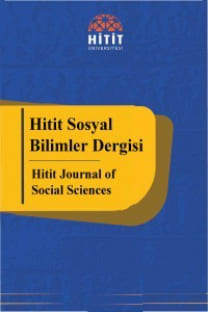UZAKTAN VE ÖRGÜN EĞİTİM ÖĞRENCİLERİNİN AKADEMİK BAŞARI PERFORMANSLARINI ETKİLEYEN FAKTÖRLERİN ARAŞTIRILMASI
Son zamanlarda, yüksek öğretim kurumlarında çok sayıda uzaktan eğitim programının açıldığı ve kayıtlı öğrenci sayılarında ciddi artışlar olduğu gözlenmektedir. Uzaktan eğitimde öğrenci sayısındaki artışlar eğitimde başarıyı etkileyebilecek faktörlerin neler olabileceği sorusunu beraberinde getirmektedir. Bu çalışmada, uzaktan ve örgün eğitim öğrencilerinin demografik özellikleri, motivasyon seviyeleri, kişisel gelişim durumları ve temel bilgisayar kullanım seviyelerinin akademik başarılarına olan etkisi araştırılmıştır. Bu amaçla, uzman görüşleri alınarak anket soruları hazırlanmış ve gruplara uygulanmıştır. Araştırmanın örneklemini, Kırıkkale Üniversitesi Uzaktan Eğitim Merkezinde eğitim alan öğrencilerle Meslek Yüksekokulun’da örgün olarak öğrenim gören öğrenciler oluşturmaktadır. Anket soruları SPSS (versiyon 22.0) veri analiz paket programı ile analiz edilerek sonuçlar çizelgeler halinde verilmiştir. Uzaktan ve örgün eğitim alan öğrencilerin akademik başarıları ile araştırılan değişkenler arasında anlamlı bir farklılık olup olmadığı tespit edilerek analiz kısmında verilmiştir. Çalışmanın sonuç bölümünde elde edilen çizelgeler yorumlanarak uzaktan ve örgün eğitim birimlerine, ayrı ayrı öneriler sunulmaktadır
Anahtar Kelimeler:
uzaktan eğitim, e-öğrenme
A STUDY ON THE FACTORS AFFECTING THE ACADEMIC PERFORMANCE OF DISTANCE EDUCATION STUDENTS AND FORMAL STUDENTS
Recently the numbers of distance education programs and students enrolling in them have increased significantly. This increase also carries the question of what factors may have an effect on academic success. The demographic features, motivation levels, personal development status and basic computer literacy of students have been taken into account and their effects on the academic success of students have been analyzed. With this purpose, surveys prepared with the help of professional opinion have been applied to certain groups. The sample group of this study consists students of the Kırıkkale University Distance Education Center and the formal education students of the Kırıkkale Vocational School. The results have been analyzed with the help of the SPSS data analysis program (version 22.0) and have been turned into figures. The academic success of distance learning students and formal education students have been compared and this data has been used to identify whether there are any significant connections between academic success and the factors determined. In the conclusion of this study, the figures have been explained separately, and suggestions have been made regarding both distance education and formal education.
___
- Ainin, S. (2015) Facebook usage, socialization and academic performance, Computer & Education, 83(1), 64-73.
- Caldwell, E.R. (2006). A comparative study of three instructional modalities in a computer-programming course: traditionalinstruction, web based instruction, and online instruction. Unpublished PDH Thesis. USA: The University of North Carolina at Greensboro.
- Clark, R. C., & Kwinn, A. (2007). The new virtual classroom. San Francisco: Pfeiffer.
- Carr, S. (2000) Online psychology instruction is effective, but not satisfying, study finds. Chronicle of Higher Education, 46(27), pA48, 2/5p. Retrieved April 6, 2014 online from Academic Search Elite database.
- Dille, B., & Mezack, M. (1991). Identifying predictors of high risk among community college telecourse students. The American Journal of Distance Education, 5(1), 24-35.
- Gibson, C. C. (1998). The distance learner’s academic self-concept. In C.C. Gibson (Ed.) Distance Learners in Higher Education: Institutional responses for quality outcomes (p. 65-76). Madison, WI.: Atwood.
- Gülümbay, A. A. (2005). Yükseköğretimde Web’e Dayalı ve Yüz Yüze Ders Alan Öğrencilerin Öğrenme Stratejilerinin, Bilgisayar Kaygılarının ve Başarı Durumlarının Karşılaştırılması. Doktora Tezi. Eskişehir: Anadolu Üniversitesi.
- İşman, A. (2011). Uzaktan Eğitim. Ankara : Pegem Akademi Yayıncılık.
- Koresdoski A.E. (2000). The value of distance lerarning graduate degree prorams to employer and employees. Unpublished PDH Thesis. Nova Southeastern University.
- Kör, H. (2013). Uzaktan ve Örgün Eğitimin Öğrenci Başarısı Üzerine Etkisinin Araştırılması, Gaziantep Ünversitesi Sosyal Bilimler Dergisi, Gaziantep University Journal of Social Sciences, 2013 12(2) Technology Special Issue:267-279
- O’Neil, H. F. (Ed.). (2005). What works in distance learning: Guidelines. Greenwich, CT: Information Age.
- O’Neil, H. F. (Ed.). (2008). What works in distance learning: Sample lessons based on guidelines. Charlotte, NC: Information Age.
- Pachnowski, L. M. and Jurczyk, J. P. (2000, February). Correlating self-directed learning with distance learning success. Paper presented at the annual meeting of the Eastern Educational Research Association, Clearwater, FL. ERIC Document No. 441000.
- Reiser, R. A., & Dempsey, J. V. (Eds.). (2012). Trends and issues in instructional design and technology (3rd ed. Upper Saddle River, NJ: Erlbaum.
- Scheffe, H. (1953). A method of judging all contrasts in the analysis of variance. Biometrika, 40, 87-104.
- Scheffe, H. (1959). The analysis of variance. New York: John Wiley press.
- Schutte, J.G. (1997). Virtual teaching in higher education: The new intellectual superhighway or just another traffic jam? California State University Northridge Department of Sociology Retrieved from http://www.csun.edu/sociology/ virexp. Htm
- Soefijanto, T. (2002). An effort to implement the adventages of face to learning in distance education. Boston: Boston University.
- Souder, W.E. (1994). The effectiveness of traditional versus satellite delivery in three management of technology master’s degree programs. The American Journal of Distance Education, 7(1), 37-53
- Tukey, J. W. (1949). Comparing ındividual means in the analyses of variance. Biometrics, 5, 99-114.
- Yayın Aralığı: Yılda 2 Sayı
- Başlangıç: 2008
- Yayıncı: Hitit Üniversitesi
Sayıdaki Diğer Makaleler
MURAT GÜLSOY’UN “BABA OĞUL VE KUTSAL ROMAN” ADLI ESERİNDE YAPI VE SİMGELER
16. YÜZYIL ÇORUM NAHİYESİ'NDE NÜFUS VE YERLEŞİM ÖZELLİKLERİ
Ayhan BAYRAM, Seyhan BİLİR GÜLER
2007 SEÇİMİNİN SİYASAL DEĞER HARİTASI: SİYASETÇİLERİN SÖYLEMLERİ ÜZERİNE BİR DEĞER ANALİZİ
TÜRKİYE'DE MUHAFAZAKÂR KESİMİN DEĞİŞEN HAYAT TARZI
Burcu ORALHAN, Sevgi SÜMERLİ SARIGÜL
16. YÜZYIL ÇORUM NAHİYESİ'NDE NÜFUS VE YERLEŞİM ÖZELLİKLERİ
